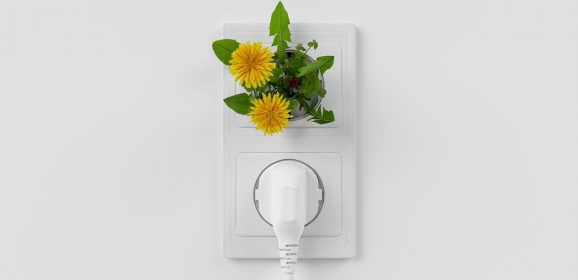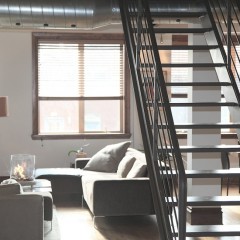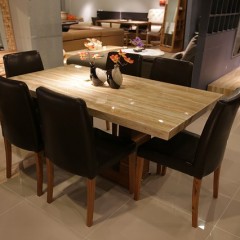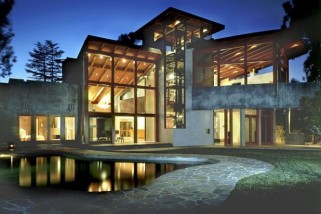How To Make a Large Room Feel Comfortable
There are many ways to divide a large space into more comfortable smaller areas in which to live, work and play but for this article I’d like to concentrate on room dividers. The clever use of a physical barrier can set the tone for the design scheme; traditional, mid-century modern, urban, scandi style or shabby chic, anything is possible. Space dividers Open plan living spaces are popular, particularly with families, and they work really well when numbers swell at party time. However very large rooms can make people feel uncomfortable and sometimes it’s difficult to arrange furniture due to the lack of walls. It feels a bit weird placing furniture in the middle of an expansive room when, having been used to smaller spaces, we would naturally place large items around the edges of a room and face them inwards. Moving from a house with several small rooms into one with an open plan arrangement can be daunting and space dividers have an important role. The open shelving shown in the image below (from Bolefloor), allows the maximum amount of light to permeate through. This has the added design benefit of creating shadows, which can be very attractive, and it means you have a visual connection through the space. The design is perfect for a contemporary look and you may wish to display items on the shelves although I must admit to liking it just the way it is. To bring pattern into a room you could try a folding screen that can be moved and adjusted to fit the space. A solid screen like the ones below (Butterflies from Timorous Beasties and parrots from WallpaperDirect) can create the effect you specifically need. Give your room a lift with joyful pattern or bold colour. If you have craft skills you could make this type of screen at home; cover with fabric, wallpaper, or paint. If you need a divider that also creates a thermal barrier a glazed wall is one to consider. The decision to have small framed panes of glass or large pieces that are unframed will be dependent on the style you want to achieve in your home. In order to decide what type of room divider you need consider the following questions:- Is it going to be permanent or do you need to move it around? For instance, will you want to take it with you to a new home or use it in another room in the future? Do you require the screen for privacy and if so, must it be completely solid or can it be semi transparent? Should the screen be more than just a visual divider? Could it be a thermal or noise barrier? Is the screen required for...
The Whole Enchilada: Stop Thinking in Terms of Rooms
Interior Design can be a bit overwhelming, especially if you have no training or serious experience with it. In fact, for many people who choose to go DIY (or must do, due to budget constraints), their gut instinct is to reduce the project’s scale down to something more mentally manageable. This usually means focusing on one room of the house at a time – or, sometimes, just one aspect of a room. Once they get the scale down to something less frightening the ideas start to come. The problem? This approach usually results in an over-designed home, or a home with a chaotic, rudderless design scheme that doesn’t feel cohesive. Beautiful, unique objects, textures, and colours won’t do much for your home if they fight with each other or don’t complement each other. Scary or not, the key to good design in the home is to think about the Big Picture. The Problem Here’s the problem: Whether you’re tackling each room as a whole separate project due to intimidation or budget, the end result is that each room feels like an island of design. On the one hand, this might make sense to you, because you’re pouring all of your creativity and resources into each space, so they will all emerge feeling “done,” with nice finishes. And that may well be true. But if you step back and walk from space to space, think about whether the colour transitions from one wholly distinct palette to another are jarring, whether the decorations on the walls and surfaces tie into each other or not, and whether you feel like you’re walking through different people’s apartments instead of one family’s home. In some cases, you want this distinction – giving a child his or her distinct space can be a great idea. But for the public areas of the home everything needs to feel like it’s part of a larger plan. The Solution The solution is simple: Step back and make sure there are visual “through lines” between each space. Take into consideration: Colour Palette: You don’t need to use the same colour palette in each room, but each colour palette should launch from the same starting point and complement each other. One great idea is to have each room shift from one end of the palette spectrum to another as you move from the front to the back of the home. Wall Art: Each piece of wall art should refer back to others in the home. Subtlety is key. Different styles of canvas prints or other wall decor all depicting similar subjects, or canvas prints made from the same photo set you took on...
Turn Your Bedroom into a Luxurious Sanctuary
Here are three tips I’m going to share with you to achieve jaw dropping luxury for your bedroom. Many of us yearn to feel pampered and special and in the privacy of your own bedroom you can make it happen in a very personal way. Budget constraints often mean that the bedroom slips down the priority list so I hope to encourage you to spend a little time to create your sanctuary. You don’t necessarily need to spend lots of money to produce sumptuous richness, it’s more about making clever choices. These ideas will help you develop your interior design scheme and take it up a level:- Soft textures: Deep buttoned headboards, quilted bed throws, upholstered chairs and ottomans all add a sense of luxury. The softness is organised, not totally informal, and it makes the difference between a luxe feel and a relaxed feel. So if you’d like to add a throw, or a pair of fluffy cushions, place them carefully rather than just anyhow. Glitter and shine: Mirrors, chandeliers, metallics and all reflective materials make the space feel glamorous and give it a touch of ‘Hollywood’. In the UK we are forever trying to bring more light into our rooms and mirrors are used freely but be careful as too many hard surfaces can make a room feel unfriendly. Include fabric that has a sheen or a wallpaper with a metallic background – both give you shine without harshness. You can also add a romantic effect with artificial light by placing a mirror behind it; this works particularly well with wall lights and pendent lamps that hang close to a wall. Generosity of scale: Wide picture frames, full fringes, large furniture, big patterns and lots of fabric in your drapes suggest opulence. If you can double the amount of anything do it! So, for instance, a single picture would be set with a minimum of two mount boards and a large fluted moulding for a frame. When thinking about the presentation of pictures or photographs hang a group of smaller ones together to make a large display. And, finally, remember to include the details, as well as looking at the room as a whole, because they can make a big difference to the overall atmosphere and complete the...
Combining the Stock and the Personal into Style
Designing the rooms in your home basically all comes down to four basic elements: the floors, the furniture, the walls, and the ceiling-slash-lighting. While all of these elements have to be brought into harmony, no one said that harmony has to be obvious. Sometimes, rooms that seem like they could never work when you first walk in eventually become your favourite ones as your brain slowly uncovers the hidden connections between every design aspect, and the plan is revealed. That’s no easy task. However, when successfully implemented these subtle connections can be awe-inspiring. One way of achieving this sort of effect is to think about your wall art a little differently: especially when you have to differentiate between the intimate and personal and the stylish and stock. The Stock/Story Divide All art can be divided into two very broad categories – personal, which tells a story and depicts you or your loved ones. Even places and things that are close to you. They represent your experiences and affections. Then there are stock pieces of art. These may be beautiful and stylish but don’t necessarily relate specifically to any personal aspect of your life. Stock art can appeal to you on a personal level, of course – which is one reason why you choose it in the first place. But that connection is rarely obvious to guests or visitors. On the other hand, photos of your family, yourself, or your travels have an obvious and immediate personal impact, warming up the room. Still, personal photos on the wall – even when presented as high-impact canvas prints – often lack the power and style of professional artwork. Too often, people assume they can have one or the other in their rooms – that they can have intimacy or style, but not both. Of course, you can have both – simply by combining your stories with style. The Stock/Story Hybrid There are several approaches that combine the high emotion of personal photos and the high style of carefully selected stock art: The Multi-Canvas Installation With a gorgeous personal photo as the centrepiece (a wedding shot, or a spectacular scene from a vacation, or that one perfect baby photo you managed to get), adding in some carefully chosen stock art creates a huge single piece of art. Choosing stock based on the colour palette of the central image, or extrapolating from the background of the main image and choosing graphic lines and shapes from that can create a powerful ‘moment’ on the wall that subtly blends the personal and the artistic. The Mix-n-Match Scenery If you’re using a powerful travel experience or location from your lives as inspiration, it’s okay to cheat a...
The New Trend: Social Media-Inspired Home Décor
Style is ephemeral. What was once the height of style and the cutting edge in design slowly ages into yesterday’s look, then into deprecated old-fashioned non-style, and finally into retro cool – a process that used to take decades but now seems to cycle through every few years. Still, the fact is that keeping a ‘fresh’ modern feel in your home isn’t always easy, and chasing trends can be dangerous. The key is moderation. Just because a trend is hot doesn’t mean you throw it around the house with wild abandon. When Travertine was the stone to use, having it in every room of the house would be overkill – and leave you with a serious problem when the worm turned and Travertine shouted ‘I created this deign before 2010!’ The New Style: Social Social Media has been a growing part of everyone’s life since about 2008, when Facebook exploded and took the concept mainstream. Since then, even people who aren’t ‘geeks’ have embraced social media sites, and created profiles, shared life events, and discovered a sleeping community of friends, co-workers, and strangers from around the world. Now that it looks like social media isn’t just a fad, the style and design elements of these platforms are creeping into home design – and right now the best way to declare your home is modern and hip is to incorporate social media touches in subtle, cool ways. Facebook Blue The blue that Facebook uses on its page isn’t some special colour whipped up by Mark Zuckerberg, it’s HTML Colour Code 3B5998 – the closest Pantone colour code for this would be 7685C. It’s becoming cool to use this as an accent colour, especially in rooms that are otherwise white or off-white, as it’s actually quite pretty when used with restraint, and brings that modern sense of social media without clubbing people over the head. Where a ‘Like’ decal with the iconic thumbs up image would be overly literal and kind of kooky, the subtle use of the colour scheme brings a friendly, sophisticated feel to your room. Framing Facebook ‘Moments’ Another way to bring Facebook into your home that makes up for being a bit more literal with emotional impact is to take momentous events in your life that you’ve posted to Facebook, taking a screen shot, and having your Facebook ‘Wall’ turned into a gorgeous, high-quality canvas print. Think pregnancy announcements complete with sonogram image, or the moment you changed your ‘relationship’ status to ‘married.’ Or perhaps just an epic photo posted by a friend that captures an amazing evening you were part of – turning that screen into...
Going Informal: Alternatives to the Formal Dining Room
Time always moves at exactly the same speed, but our perception of it alters over time. The end result is impressions such as ‘summer used to last longer when I was a kid’ or ‘it can’t possibly be spring already!’ Just like our perception of time as individuals, time moves on for society overall as well. This can be seen pretty clearly when you examine homes built at different times in history: Rooms that were once absolute necessities become oddball spaces no one knows what to do with, floor plans evolve and change, and buildings that were once grand mansions get subdivided into more humble apartments. The Formal Dining Room is quickly becoming one of those dinosaurs of a past age. While there are certainly still families that use and love their Formal Dining Room, there are more and more families that are embracing a more casual use of space and have rarely, if ever, used the Formal Dining Room for its assigned purpose. Ask yourself: When was the last time you invited a dozen people over and used your buffet, China Cabinet, and good place settings? If the answer is pretty low, you might consider doing something else with your Formal Dining Room – because it’s turning into wasted space. Keep Things Appropriate Once you decide that the Formal Dining Room is a waste of space, you can, of course, do anything you want with it. Some folks have turned it into a game room complete with pool table. Others into a home office or children’s play room. However, just because you suddenly have a few dozen square feet to play with doesn’t mean that the room can be anything and remain appropriate in the home. While you can decide to use your space any way you like, the fact is Formal Dining Rooms tend to be off the kitchen, and that means having an office or a playroom – while perfectly sensible – won’t flow well with the house. To truly re-imagine your Formal Dining Room without ruining your home’s flow and balance, keep the new use in line with its placement. Dining Room Reinvention Ideas Here are some ideal uses for the space that make the room more useful and keep things making sense in your home: Kitchen Renovation The Dining Room is right off the kitchen – and thus could easily be where you expand in order to create the eat-in kitchen of your dreams. If your kitchen’s a bit tight or a bit dark, this is the easiest way to recreate it and gain valuable square footage. Of course, this is a drastic step...

















